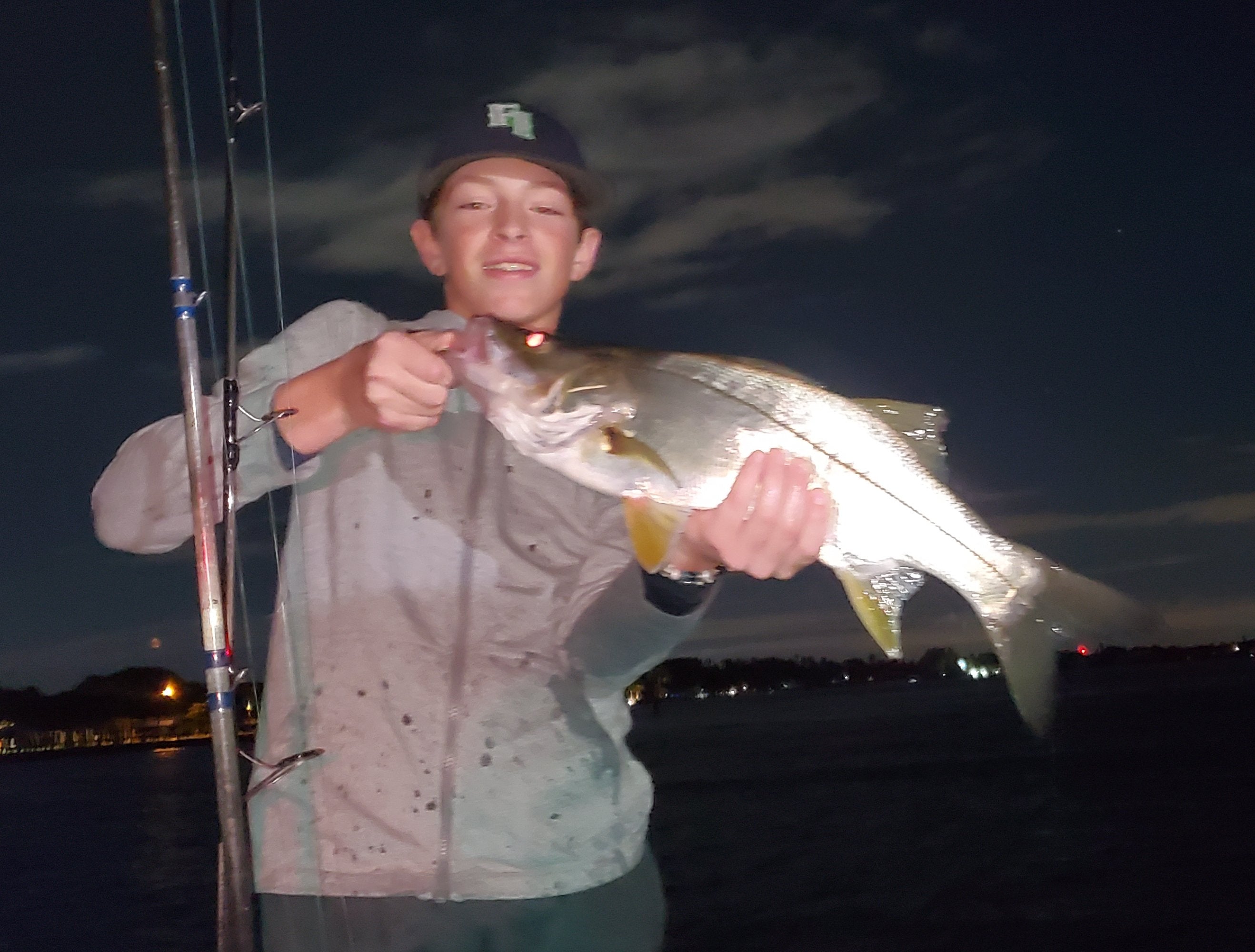Nighttime Snook Secrets & Top 4 Artificial Lures Revealed
Greetings, fellow sleepless snook junkies! Capt. Carlos here, from the sunny-soaked shores of Florida, ready to dive into one of my favorite obsessions: nighttime snook fishing. There's something magical about the calm and mystery of fishing after the sun sets, especially when you're targeting the elusive, bait busting, & hard fighting snook. Over 3 decades, I've honed my techniques and gear to maximize success, and today, I'm stoked to share with you my top 4 artificial lures for snook fishing at night.

The Suspending Bait - A Silent Assassin:
- One of my go-to lures for nighttime snook fishing is the suspending twitch bait which can be in the form of a hard plastic body or leading hybrid soft plastic materials. These lures are designed to mimic a wounded baitfish, an irresistible meal for a hungry snook. The subtle presentation and lethargic movements is where this bait excels and helps antagonize the fish to trigger a reaction bite. Frankly speaking, this bait just pisses snook off enough to get them to commit and strike!
Why It Works:
At night, snook rely heavily on their keen sense of vibration and movement in the water. The subtle twitching motion of this lure, combined with its ability to suspend in the water column, triggers an instinctive strike response. Snook seeing these lethargic movements as an opportunity to capitalize on an easy meal.
How to Use:
Cast near structures like docks, mangroves, or bridge pilings where snook like to ambush prey. Use a twitch-and-pause retrieve, allowing the lure to suspend and entice those predators lurking in the shadows.
- The Topwater Plug - Surface Explosions & Action
There's nothing more exhilarating than watching a snook explode on a topwater plug in the dead of night. The disturbance these lures create on the water's surface is a major attractant. Sometimes a subtle topwater lure with minimal movements and the tide flow doing it's thing will get the bite. We've experienced this the last few years during the mullet migration and found that fishing a segmented topwater lure super slow during a tide that is slowing up, was consistent in getting bites back to back.

Why It Works:
Snook are opportunistic feeders, and the commotion of a topwater plug imitates an injured fish at the surface, an easy target for a big snook. Breeders do not like to expel energy for no apparent reason and every meal is very calculated with precise amounts of energy exerted when feeding.
How to Use:
- Best used in calmer waters, work the plug with a steady “walk-the-dog” action. Be ready for aggressive strikes, often occurring just as the lure pauses.
- The Soft Plastic Paddle Tail or weighted swimbait - Versatile and Deadly
Soft plastic paddle tails are a versatile option, perfect for varying conditions and depths. Their lifelike swimming action is irresistible to snook. Having a few sizes and patterns that match the bait in the area will increase you chances of consistently getting bit.

Why It Works:
These lures closely resemble the look and movement of a real fish, triggering predatory instincts in snook. Their versatility allows you to fish them at different depths and speeds. The swimbait is especially deadly when working bridges, docks, or any shadow line near heavy structure where snook tend to stack up and wait to ambush their prey. Casting up current 10-20ft, allowing the lure to sink, and then working it along the shadow line at a steady pace is a fairly consistent pattern to finding a bite.
How to Use:
Rigged on a jig head or pre-rigged like the Mulletron from Z-man or Marea Fishing's Motion Minnow, you can bounce them along the bottom or swim them through the water column. Experiment with retrieve speeds to mimic different types of baitfish.
The Shrimp Imitation - Natural Appeal
- For snook, a shrimp is like candy. Shrimp imitations are fantastic for night fishing, closely mimicking one of the snook’s favorite meals.
Why It Works:
These lures are designed to replicate the look and movement of a live shrimp, appealing to the snook's keen sense of sight and vibration detection at night.
How to Use:
Fish them using a 3-4ft leader of 30-50lb fluorocarbon and free-line them near structures such as docks, bridge pilings, rock jetties, pier, or seawalls. The general rule of thump in the heavier the structure, the heavier the leader. It's not out of the question for certain keys spots to bump up to 80lb or even #6 stainless wire when you're feeling really frisky on an outgoing tide. The key is a slow and natural retrieve, with an occasional - pop imitating a shrimp's erratic swimming.
Summing it up, these four lures have proven to be incredibly effective in my nighttime snook fishing missions over the last few decades. Remember, the key to successful snook fishing at night is not just the choice of lure but also understanding the behavior of these magnificent fish and adapting to their habits quickly. Being observant to what forage the fish are feeding on any given night will also elevate your fish catch ratio and at times leave the live baiters saying "WTH?"
Tips for Success
Familiarize yourself with the local waters and snook behavior in the area. Tide and Current: Pay attention to the tide and current, as snook often feed more actively during moving water. They will sometimes eat better on a flood tide in correlation to the moon phase. I have found that all gibbous phases tend to "give us" bites or fish.
Stealth Approach: Be as quiet as possible; snook are wary and can be easily spooked. Do not fish next to people who are throwing cast nets attempting to catch bait. It’s a waste of time- the fish will get spooked!
Patience and Persistence: Night fishing requires patience. Be ready to adapt your techniques and keep trying.
I hope these tips help you on your next nighttime snook mission.
Tight lines, and Ripping Drags!





